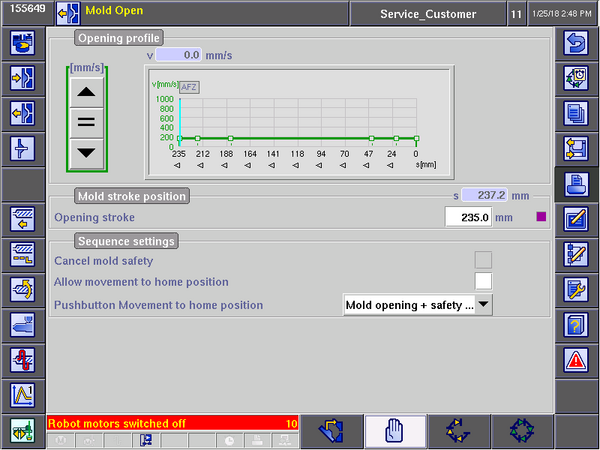Specific Process Knowledge/Back-end processing/Polymer Injection Molder/Demolding
Demolding
Demolding is the process of opening the mold and thereby pulling the sample off the shim. Many of the previously mentioned parameter will influence the demolding process. Generally, the higher mold temperature, faster injection speed and higher injection/after pressure, the more difficult it will be to demold the sample.
The dosing/plasticizing settings are found on the 'Plasticizing' screen:

- Dosing speed: Dosing speed is adjusted by pressing the left (green) '=' sign and entering a value. Alternatively the up/down arrow can be used or the points of the green graph may be edited directly. It is recommended not to increase the speed above ~0,34 m/s. For sensitive polymers it may be necessary to lower the speed.
- Back pressure: The back pressure is adjusted by pressing the right (red) '=' sign and entering a value, using the arrows or editing the red curve points directly. During dosing the only thing that moves the screw backwards is polymer entering the cylinder and thus pushing the screw backwards. A back pressure is used to "press against" this motion. The higher the back pressure the harder 'kneading' of the polymer. Again, some sensitive polymers might require reduced back pressures to avoid thermal damage (decomposition) of the polymer. It is usually sufficient to keep the back pressure at 120 bars or below, but in some cases (e.g. when using pigments) a higher back pressure can give better mixing of pigment and polymer. But be aware of the risks involved regarding decomposition of the polymer.
- Shot volume: This is the setpoint for the amount of polymer that is loaded into the heating cylinder. Note that this number is in no way linked to the amount of polymer injected into the mold cavity. This is defined on the "Switchover" screen mentioned earlier.
- Plasticizing time monitoring: It is recommended to always keep this enabled (it must remain enabled if leaving the machine unattended) to make sure the machine stops in case of errors. Usually the maximum plasticizing time is set around 4-8 times the actual plasticizing time (which can be seen in the light blue field just above the setpoint). In this particular screenshot it shows 0,00 sec because no samples has been produced yet after the machine was started.
- Decompression: To avoid problems with stress in the polymer melt it can be a good idea to enable decompression. A setpoint of 1 cm3 works well for most cases. This means that after plasticizing the screw moves a little further backwards to provide space for the polymer melt to relax. This is particularly beneficial when running at high back pressure.
